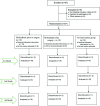Comparison of the effect of the pelvic floor muscle biofeedback prior or postradical prostatectomy on urinary incontinence: A randomized controlled trial
- PMID: 35118982
- PMCID: PMC9612772
- DOI: 10.5152/tud.2021.21096
Comparison of the effect of the pelvic floor muscle biofeedback prior or postradical prostatectomy on urinary incontinence: A randomized controlled trial
Abstract
Objective: This study aimed to evaluate the pre- and postoperative effects of pelvic floor muscle training (PFMT) and the biofeedback method on the management of urinary incontinence (UI) in patients who underwent radical prostatectomy (RP).
Material and methods: Fifty-seven patients were enrolled in this study from September 2019 to July 2020. They were randomly divided into three groups each of 19 patients: two case groups (biofeedback before and after RP) and a control group. All patients underwent RP, followed by PFMT and 24-hour pad use instructions after the postoperative removal of the Foley catheter. Then, the rate of patient-reported pads/day usage was recorded and compared among the three groups at the end of the 1st, 3rd, and 6th months of catheter removal.
Results: Compared with the control group (only 15%), 63 and 52% of the patients who used pre- or postoperative treatment interventions, respectively, regained urinary continence during the first postoperative period, showing significant downward rates of pads/day use (P ¼ .01 and .001, respectively). However, the results were not significant between the two case groups.
Conclusion: Our study revealed that applying the biofeedback method for pelvic floor muscles could be an efficient interventional approach in patients with UI, leading to the earlier regaining of continence following RP.
Conflict of interest statement
Figures
References
LinkOut - more resources
Full Text Sources

